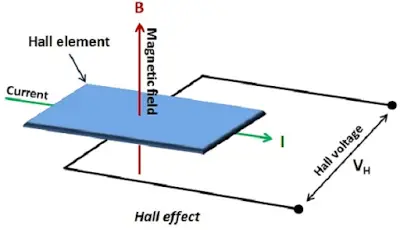Hall Effect Transducers
Contents
show
Hall Effect Transducers are the transducers which work on the principle of hall effect. According to hall effect, if a conducting material strip carries current in the presence of a transverse magnetic field; an EMF is produced between two edges of the conductor in a direction perpendicular to both the magnetic field and the direction of the current as shown in the figure below.
The output voltage is given by
where, KH = Hall Effect Coefficient
I = current
B = magnetic flux density
t = thickness of the strip(hall element)
The emf produced is called as Hall voltage and depends upon the current, flux density and a property of conductor known as Hall Effect Coefficient (KH).
The strip of conducting material is called a Hall element. The hall voltage is only produced when directions of the current and magnetic field are perpendicular to each other as shown above.
Hall effect occurs in metals and semiconductors. The produced hall voltage can be used to measure either the current or the magnetic field.
Applications of Hall Effect Transducers
1. It is used as magnetic to an electric transducer to measure the magnetic field.
2. It is used for the measurement of displacement.
3. It is used for the measurement of a.c. or d.c. current.
4. It is used for the measurement of power.
5. Open/close detection of laptop flip screen. Hence conserve power while switching laptop to sleep.
6. Variable speed drives
7. Used in Flowmeters
8. Used in Encoded switches
9. Used in Motor control protection/indicators
10. Used in Rotary encoders
Advantages of Hall Effect Transducers
1. True solid state
2. It has a long life. Hall Effect transducers are not affected by ambient conditions such as rain, dust, humidity, vibrations, etc.
3. It has high-speed operation (over 100 kHz is possible)
4. It operates with stationary input.
5. There is no wear and tear since moving parts are absent.
6. It can be operated over a broad temperature range from -40 °C to +150°C.
7. It has a highly repeatable operation.
Disadvantages of Hall Effect Transducers
1. Not capable of measuring a current flow at a distance greater than 10 cm.
2. Since hall effect utilizes magnetic field for measurement, the Stray magnetic field may cause inaccurate readings.
Exercise
Q. Describe the construction and principle of working of Hall Effect transducers.Q. What are properties of a semiconductor determined from a Hall effect?
Ans. The hall effect is used to determinea. whether a semiconductor is P-type or N-type.
b. carrier concentration
c. measure the conductivity of a material and then compute mobility.
Ans. The hall effect is used to determinea. whether a semiconductor is P-type or N-type.
b. carrier concentration
c. measure the conductivity of a material and then compute mobility.
Q. How to differentiate between a p-type and an n-type semiconductor using Hall Effect?
Q. What is Hall coefficient? Where is it used?
Q. “Hall effect has played a decisive role in revealing the mechanism of conduction in semiconductors.” Explain the statement.


